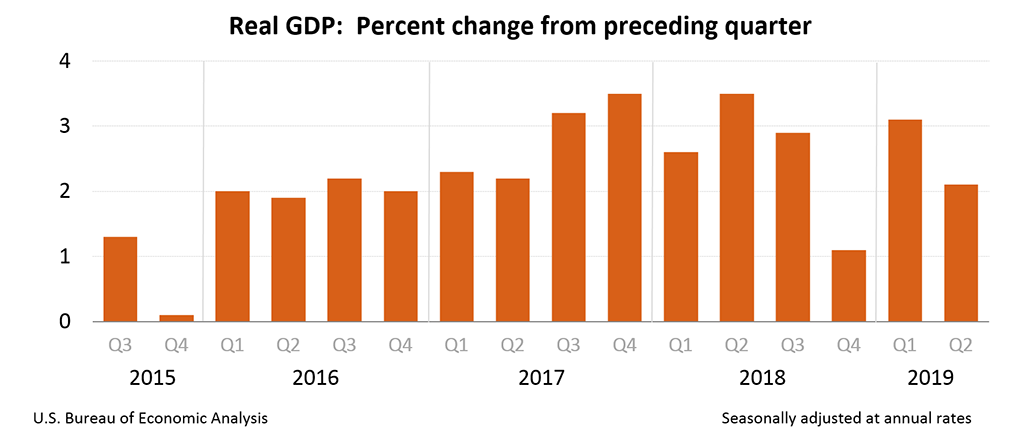Washington, DC….Real gross domestic product (GDP) increased at an annual rate of 2.1 percent in the second quarter of 2019 (table 1), according to the “advance” estimate released by the Bureau of Economic Analysis. In the first quarter, real GDP increased 3.1 percent. The Bureau’s second-quarter advance estimate released today is based on source data that are incomplete or subject to further revision by the source agency (see “Source Data for the Advance Estimate” on page 2). The “second” estimate for the second quarter, based on more complete data, will be released on August 29, 2019.

The increase in real GDP in the second quarter reflected positive contributions from personal consumption expenditures (PCE), federal government spending, and state and local government spending that were partly offset by negative contributions from private inventory investment, exports, nonresidential fixed investment and residential fixed investment. Imports, which are a subtraction in the calculation of GDP, increased (table 2).
The deceleration in real GDP in the second quarter reflected downturns in inventory investment, exports, and nonresidential fixed investment. These downturns were partly offset by accelerations in PCE and federal government spending.
Current-dollar GDP increased 4.6 percent, or $239.1 billion, in the second quarter to a level of $21.34 trillion. In the first quarter, current-dollar GDP increased 3.9 percent, or $201.0 billion (table 1 and table 3).
The price index for gross domestic purchases increased 2.2 percent in the second quarter, compared with an increase of 0.8 percent in the first quarter (table 4). The PCE price index increased 2.3 percent, compared with an increase of 0.4 percent. Excluding food and energy prices, the PCE price index increased 1.8 percent, compared with an increase of 1.1 percent.
Personal Income (table 8)
Current-dollar personal income increased $244.2 billion in the second quarter, compared with an increase of $269.8 billion in the first quarter. Decelerations in compensation and in personal current transfer receipts were partly offset by an upturn in personal income receipts on assets and a deceleration in contributions for government social insurance (a subtraction in the calculation of personal income).
Disposable personal income increased $193.4 billion, or 4.9 percent, in the second quarter, compared with an increase of $190.6 billion, or 4.8 percent, in the first quarter. Real disposable personal income increased 2.5 percent, compared with an increase of 4.4 percent.
Personal saving was $1.32 trillion in the second quarter, compared with $1.37 trillion in the first quarter. The personal saving rate — personal saving as a percentage of disposable personal income — was 8.1 percent in the second quarter, compared with 8.5 percent in the first quarter.
Source Data for the Advance Estimate
Information on the source data and key assumptions used for unavailable source data in the advance estimate is provided in a Technical Note that is posted with the news release on BEA’s Web site. A detailed “Key Source Data and Assumptions” file is also posted for each release. For information on updates to GDP, see the “Additional Information” section that follows.
Annual Update of the National Income and Product Accounts
The estimates released today also reflect the results of the Annual Update of the National Income and Product Accounts (NIPAs). The update covers the first quarter of 2014 through the first quarter of 2019.
With today’s release, most NIPA tables are available through BEA’s Interactive Data application on the BEA Web site (www.bea.gov). See “Information on Updates to the National Income and Product Accounts” for the complete table release schedule and a summary of results for 2014 through 2018, which includes a discussion of methodology changes. A table showing the major current‑dollar revisions and their sources for each component of GDP, national income, and personal income is also provided. The August 2019 Survey of Current Business will contain an article describing the update in more detail.
Previously published estimates, which are superseded by today’s release, are found in BEA’s archives.
Updates for the first quarter of 2019
For the first quarter of 2019, real GDP is estimated to have increased 3.1 percent (table 1), the same as previously published. Downward revisions to exports, state and local government spending, and private inventory investment were offset by upward revisions to PCE and federal government spending.
For the period of expansion from the second quarter of 2009 to the first quarter of 2019, real GDP increased at an annual rate of 2.3 percent, the same as previously published.
Real GDI is now estimated to have increased 3.2 percent in the first quarter (table 1); in the previously published estimates, first-quarter GDI was estimated to have increased 1.0 percent.
| First Quarter 2019 | |||||
|---|---|---|---|---|---|
| Previous Estimate | Revised | ||||
| Percent change from preceding quarter | |||||
| Real GDP | 3.1 | 3.1 | |||
| Current-dollar GDP | 3.8 | 3.9 | |||
| Real GDI | 1.0 | 3.2 | |||
| Average of Real GDP and GDI | 2.1 | 3.1 | |||
| Gross domestic purchases price index | 0.8 | 0.8 | |||
| PCE price index | 0.5 | 0.4 | |||
* * *
Next release, August 29, 2019 at 8:30 A.M. EDT
Gross Domestic Product, Second Quarter 2019 (Second Estimate)
Corporate Profits, Second Quarter 2019 (Preliminary Estimate)


